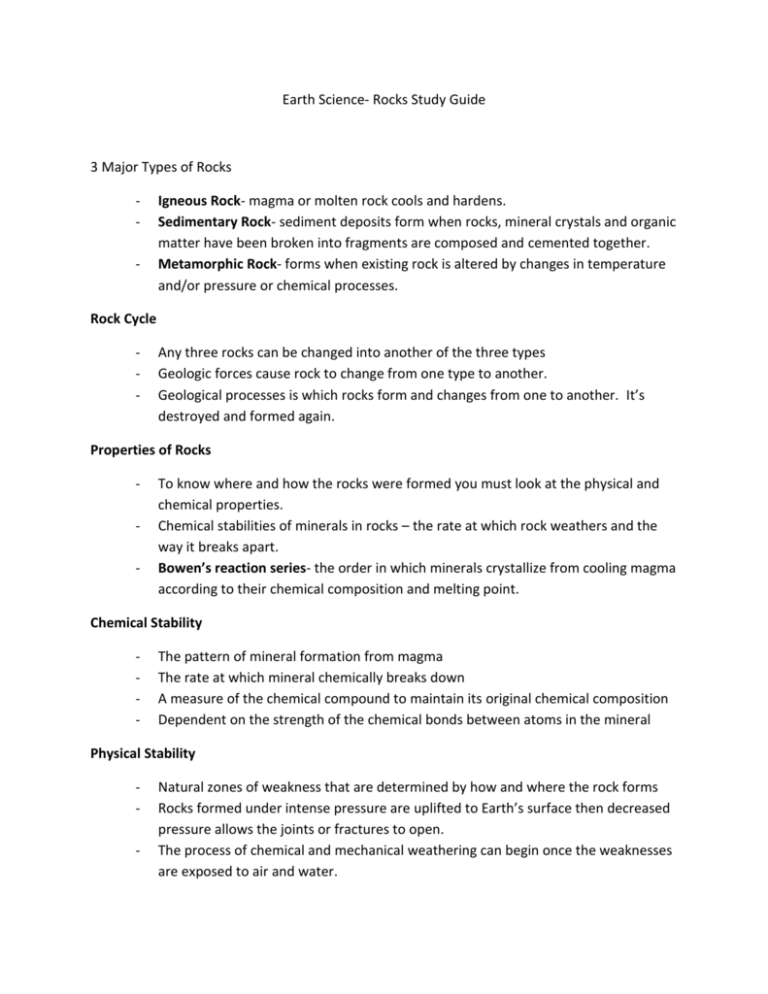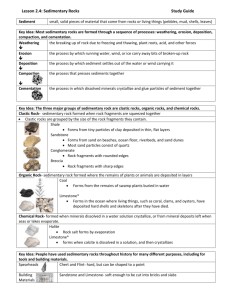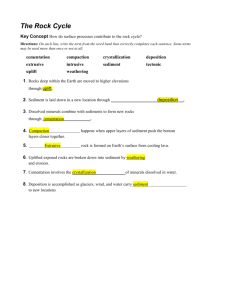Study Me
advertisement

Earth Science- Rocks Study Guide 3 Major Types of Rocks - Igneous Rock- magma or molten rock cools and hardens. Sedimentary Rock- sediment deposits form when rocks, mineral crystals and organic matter have been broken into fragments are composed and cemented together. Metamorphic Rock- forms when existing rock is altered by changes in temperature and/or pressure or chemical processes. Rock Cycle - Any three rocks can be changed into another of the three types Geologic forces cause rock to change from one type to another. Geological processes is which rocks form and changes from one to another. It’s destroyed and formed again. Properties of Rocks - To know where and how the rocks were formed you must look at the physical and chemical properties. Chemical stabilities of minerals in rocks – the rate at which rock weathers and the way it breaks apart. Bowen’s reaction series- the order in which minerals crystallize from cooling magma according to their chemical composition and melting point. Chemical Stability - The pattern of mineral formation from magma The rate at which mineral chemically breaks down A measure of the chemical compound to maintain its original chemical composition Dependent on the strength of the chemical bonds between atoms in the mineral Physical Stability - Natural zones of weakness that are determined by how and where the rock forms Rocks formed under intense pressure are uplifted to Earth’s surface then decreased pressure allows the joints or fractures to open. The process of chemical and mechanical weathering can begin once the weaknesses are exposed to air and water. Igneous Rocks - Igneous rocks- rock that forms when magma cools and solidifies. 3 factors that affect whether rocks melt - Temperature- when temperature of rock increases to above the melting point of minerals in rock Pressure- when excess pressure is removed from rock that is hotter than its melting point Presence of fluids in the rock- when fluids such as water are added. The addition of fluids generally decreases the melting point of certain minerals in the rock Partial Melting - Minerals that have lower melting points are the first to melt As temperature increases and other minerals melt the magma’s composition changes Process which different minerals melt at different temperatures Fractional Crystallization - Crystallization and removal of different minerals from the cooling magma When magma cools the process is the reverse of the process of partial melting Minerals that have the highest freezing point crystallize first Felsic Rock- light in color Mafic Rock- dark in color Intermediate Rock- medium in color Batholiths, Laccoliths, Sills and Dykes- Label the diagram Metamorphic Rocks Metamorphism- process in which one type of rock changes into metamorphic rock because of the chemical processes or changes in the temperature or pressure. - Heat, pressure and hot fluids cause change Size and shape gives rocks a layered appearance Two types of metamorphism - Contact metamorphism- a change in texture, structure or chemical composition of a rock due to contact with magma Regional metamorphism- a change in texture, structure or chemical composition of a rock due to changes in temperature and pressure over a large area, generally are a result of tectonic forces Sedimentary Rocks- made up of different types of sediment Two main processes convert loose sediment into sedimentary rock: - Compaction- volume and porosity of a sediment is decreased by the weight of overlying sediments as a result of burial beneath other sediments Cementation- minerals precipitate into pore spaces between sediment grains and bind sediments together to form rock Three main classes of sedimentary rock: - Chemical Sedimentary Rocks- rocks that form when minerals precipitate from a solution or settle from suspension. Give one example: Gypsum Organic Sedimentary Rocks- rock that forms from the remains of plants or animals. Give on example: Coal Clastic Sedimentary Rocks- rock that forms when fragments of preexisting rocks are compacted and cemented together. Give on example: Shale Rock Features- This section will be matching Stratification- layering of sedimentary rocks Cross-beds or slanting layers- commonly form in sand dunes or river beds Graded bedding- various sizes and kinds of materials are deposited in one layer, with the largest grains at the bottom and the finest grains at the top Ripple marks- form when air or water flows over sand to form ripples and the ripples are preserved in the rock. Form at a beach or on a river bed Mud cracks- form when muddy deposits form and shrink. The shrinking causes the drying mud to crack. Fossils- the remains of organisms that are preserved in rock Concretions- lumps of minerals that precipitate from fluids and build up around a nucleus or in a cavity in existing rock







